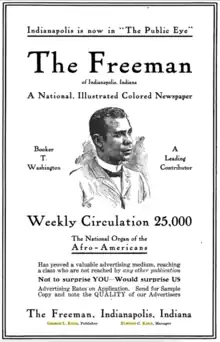| A National Illustrated Colored Newspaper | |
 | |
 Advertisement for The Freeman | |
| Type | Weekly newspaper |
|---|---|
| Format | Broadsheet |
| Owner(s) |
|
| Founder(s) | Louis Howland [O 1][1] |
| Publisher | George L. Knox and Elwood C. Knox |
| Founded | 1884[1] |
| Ceased publication | 1926 |
| Headquarters | Indianapolis, Indiana, U.S. |
| Country | United States |
| Circulation | 25,000 |
The Indianapolis Freeman (1884–1926) was the first illustrated black newspaper in the United States.[2] Founder and owner Louis Howland, who was soon replaced by Edward Elder Cooper, published its first print edition on November 20, 1884.[2][1]
History
Cooper sold the paper to George L. Knox in 1892. Knox shifted the paper's political allegiance from Democratic to Republican because he was one of the most influential Black Republicans in Indiana. The paper shifted back toward the Democratic Party in its final days due to the power of the Ku Klux Klan over the Indiana Republican Party.[3]
Knox was the publisher from 1893 to 1926. The paper was called "A National Illustrated Colored Newspaper" and was referred to as a national race paper. It had a circulation of 25,000.[4] Sold internationally, it covered everything from small Black communities to sports and entertainment. Booker T. Washington was a contributor. The paper came out on Sundays and it was said its negative review could ruin a career.[5] Hurt by inflation following World War I and competition from the more locally focused Indianapolis Recorder, the paper ceased publication in 1926.[6][7]
The paper frequently featured the writings of Richard W. Thompson, who was managing editor from 1888 to 1893.[8]
Historic significance
Unlike other Black newspapers that reprinted photographs, woodcuts, and drawings at the time, the Indianapolis Freeman had a full staff of African American artists dedicated to producing original illustrations for the newspaper. The paper published representations of blackness created by Black artists for a Black viewership. The intention of the newspaper to replace white perceptions of blackness with Black representation of blackness was noted by repetition of the phrases "as observed by the Freeman's Artist" and "as seen by the artist" in illustration captions.[9]
The Freeman employed Black agents across the country from its start, claiming to have over 200 agents in towns and cities nationally by 1914. The Freeman boasted the largest circulation of any Black newspaper, and the publication included more advertisements for Black entertainment than any other paper.[10]
References
- 1 2 3 "The Freeman (Indianapolis Ind.) 1884-1927". loc.gov. Library of congress. Retrieved September 26, 2021.
- 1 2 Ratzlaff, Aleen J. (2009). "Illustrated African American Journalism: Political Cartooning in the Indianapolis Freeman". In Sachsman, David B. (ed.). Seeking a voice: images of race and gender in the 19th century press. S. Kittrell Rushing, Roy Morris, Jr. West Lafayette: Purdue UP. pp. 131–140. ISBN 9781557535054.
- ↑ "The Indianapolis Freeman Newspaper formed". aaregistry.org. AAREG. Retrieved September 26, 2021.
- ↑ Ad Sense. New York: The New York Magazine. 1905. p. 96. Retrieved September 26, 2021.
- ↑ Watkins, Clifford. Showman. Jackson, Mississippi: University Press of Mississippi. pp. 17–18. ISBN 1-57806-555-0. Retrieved September 26, 2021.
- ↑ Taylor Jr., Robert M. (1994). "Indianapolis Freeman". In David J. Bodenhamer (ed.). The Encyclopedia of Indianapolis. Robert Graham Barrows. Indiana UP. p. 781. ISBN 9780253312228. Retrieved April 5, 2012.
- ↑ Giffin, William W. (June 1, 1983). "The Political Realignment of Black Voters in Indianapolis, 1924". Indiana Magazine of History – via scholarworks.iu.edu.
- ↑ Booker T. Washington, Louis R. Harlan, The Booker T. Washington Papers: 1899-1900 University of Illinois Press, 1976
- ↑ Williams, Andreá (2015). "Cultivating Black Visuality: The Controversy over Cartoons in the Indianapolis "Freeman"". American Periodicals. 25 (2): 124–138. doi:10.1353/amp.2015.0032. S2CID 194112538.
- ↑ Thornbrough, Emma (1966). "American Negro Newspapers, 1880-1914". Business History Review. 40 (4): 467–490. doi:10.2307/3112124. JSTOR 3112124. S2CID 154420806.
Notes
- ↑ The library of congress has Louis Howland as the creator of this newspaper